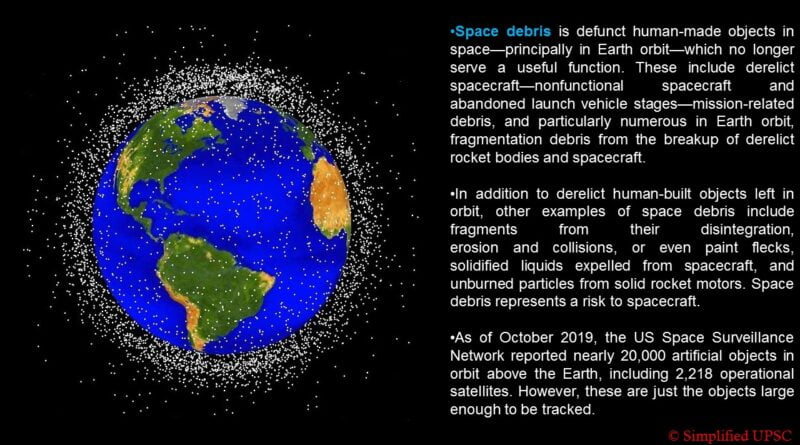Space debris
Context:
Aiming to develop a method to predict collision from space debris, Indraprastha Institute of Information Technology (IIIT), Delhi, has received research funding from the National Super Computing Mission (NSM), implemented by the department of science and technology (DST).
The project titled ‘Orbit computation of Resident Space Objects for Space Situational Awareness’ has to be completed in two years.
What is Space Debris?
- Space debris is defunct human-made objects in space—principally in Earth orbit—which no longer serve a useful function. These include derelict spacecraft—nonfunctional spacecraft and abandoned launch vehicle stages—mission-related debris, and particularly numerous in Earth orbit, fragmentation debris from the breakup of derelict rocket bodies and spacecraft.
- In addition to derelict human-built objects left in orbit, other examples of space debris include fragments from their disintegration, erosion and collisions, or even paint flecks, solidified liquids expelled from spacecraft, and unburned particles from solid rocket motors. Space debris represents a risk to spacecraft.
- Space debris is typically a negative externality—it creates an external cost on others from the initial action to launch or use a spacecraft in near-Earth orbit—a cost that is typically not taken into account nor fully accounted for in the cost by the launcher or payload owner.
- Several spacecraft, both manned and unmanned, have been damaged or destroyed by space debris. The measurement, mitigation, and potential removal of debris are conducted by some participants in the space industry.
- As of October 2019, the US Space Surveillance Network reported nearly 20,000 artificial objects in orbit above the Earth, including 2,218 operational satellites. However, these are just the objects large enough to be tracked.
- As of January 2019, more than 128 million pieces of debris smaller than 1 cm (0.4 in), about 900,000 pieces of debris 1–10 cm, and around 34,000 of pieces larger than 10 cm were estimated to be in orbit around the Earth. When the smallest objects of human-made space debris (paint flecks, solid rocket exhaust particles, etc.) are grouped with micrometeoroids, they are together sometimes referred to by space agencies as MMOD (Micrometeoroid and Orbital Debris).
- Collisions with debris have become a hazard to spacecraft; the smallest objects cause damage akin to sandblasting, especially to solar panels and optics like telescopes or star trackers that cannot easily be protected by a ballistic shield.
- Below 2,000 km (1,200 mi) Earth-altitude, pieces of debris are denser than meteoroids; most are dust from solid rocket motors, surface erosion debris like paint flakes, and frozen coolant from RORSAT (nuclear-powered satellites). For comparison, the International Space Station orbits in the 300–400 kilometres (190–250 mi) range, while the two most recent large debris events—the 2007 Chinese antisat weapon test and the 2009 satellite collision—occurred at 800 to 900 kilometres (500 to 560 mi) altitude. The ISS has Whipple shielding to resist damage from small MMOD; however, known debris with a collision chance over 1/10,000 are avoided by maneuvering the station.
Significance of the Project:
Outcome of this project will directly support the Indian space sector, valued at $7 billion (Rs 51,334 crore) by providing an operationally flexible, scalable, transparent and indigenous collision probability solution.
Netra:
To safeguard its space assets from space debris, Isro had set up a dedicated Space Situational Awareness (SSA) Control Centre named “Netra” in Bengaluru last December.
- Netra’s key objective is to monitor, track and protect the national space assets and function as a hub of all SSA activities.
- Only the US, Russia and Europe have similar facilities in place to track space objects and share collision warnings.

